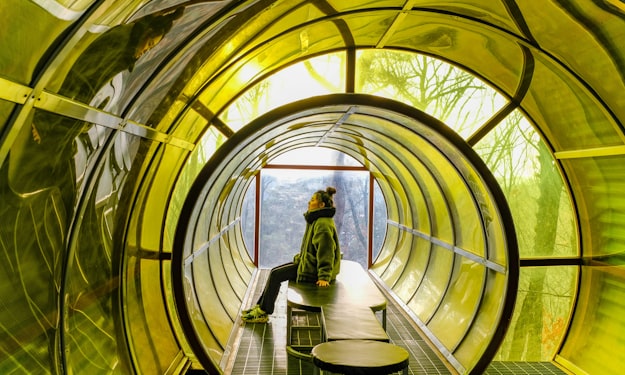habitat
The natural home and environment for all things sci fi, including future homes and territories.


The Quest Beyond Earth
The History of the Space Race The Origins of the Space Race The space race between the United States and the Soviet Union began as an extension of the ideological and geopolitical rivalry of the Cold War. With the launch of the Soviet satellite Sputnik 1 on October 4, 1957, the world witnessed the dawn of the space age. This event marked the starting point of the space race, as the Soviet Union demonstrated its technological prowess by becoming the first nation to put a satellite into orbit. The United States, caught off guard by this achievement, realized the need to catch up and surpass its Cold War adversary in space exploration.
Écrivain PlacardPublished 9 months ago in Futurism

If the Sun Suddenly Disappeared What Would Happen? Would We Survive?
ntroduction The scenario of the sun suddenly disappearing from our solar system is a fascinating and terrifying thought. In this blog post, we will explore what would happen to Earth, the moon, and other planets if such an event occurred.
Chinaza OkoriePublished 9 months ago in Futurism

The Reasons for Mars Colonization
The exploration and colonization of Mars have captured the imagination of humanity for decades. Mars, our neighbouring planet, presents a myriad of opportunities and challenges that beckon us to venture beyond Earth’s boundaries. As we stand on the cusp of a new era in space exploration, the question arises: Why should humans live on Mars? The reasons are abundant and compelling, rooted in scientific discovery, technological advancement, and the indomitable human spirit of exploration. By establishing a human presence on Mars, we open doors to unparalleled possibilities, pushing the limits of our knowledge, inspiring future generations, and fostering global cooperation. In this essay, we will delve into the multifaceted reasons why human habitation on Mars is not just a distant dream, but a crucial and transformative endeavour that holds immense promise for the future of our species and the continued exploration of the cosmos.
The World-Ending Experiments That Almost Unleashed Apocalypse
"From Hellish Drills to Cosmic Collisions: The World-Ending Experiments That Almost Unleashed Apocalypse" In the pursuit of knowledge and scientific progress, humanity has embarked on numerous experiments throughout history. However, some of these endeavors were so perilous that they could have triggered catastrophic events with apocalyptic consequences. From drilling into the depths of the Earth to tampering with deadly pathogens, and even contemplating interstellar messages to unknown civilizations, these chilling experiments have left the world on the brink of disaster. Join us as we delve into some of the most hair-raising and heart-stopping scientific trials that could have ended the world.
Dennis Thomas IVPublished 9 months ago in FuturismStrange places People Really live
Resilient Humans: Thriving in Extraordinary Places Humans are remarkable creatures, capable of adapting to and inhabiting some of the most extraordinary and bizarre places on Earth. While some individuals might find their living situations eccentric or extreme, these resilient people have carved out homes in unusual locations, showcasing the diversity of human existence. From cities engulfed in garbage to tiny islands and dangerous landscapes, let's explore some of the strangest places where people have actually made their abodes.
Dennis Thomas IVPublished 9 months ago in FuturismUnraveling the Trauma Response
Unraveling the Trauma Response: Understanding Clutter After Narcissistic Abuse The aftermath of narcissistic abuse can leave survivors grappling with complex trauma responses, one of which is clutter. While clutter is commonly associated with physical mess, in the context of narcissistic abuse, it represents a deeper psychological struggle. In this article, we will delve into the relationship between clutter and narcissistic abuse, shedding light on the trauma experienced and offering steps for resolution.
Dennis Thomas IVPublished 9 months ago in Futurism

Why does AI abhor these eight horrific acts committed by humans?
Extreme cruelty and horrific atrocities that have resulted in unimaginable suffering and loss have left their mark on human history. Humans have perpetrated atrocious actions against one another throughout history, leaving scars on collective memory. There is, however, hope for a more understanding and caring world among the gloom. We will look at a variety of historical and contemporary examples of human cruelty in this article, reflecting on the past while attempting to motivate constructive change for the future.
Aditya Aashish SinghPublished 9 months ago in Futurism

The Future of the Human Body: Advancements and Ethical Considerations
The future of the human body is a topic that has captured the imagination of scientists, futurists, and thinkers for centuries. As advancements in technology and medicine continue to accelerate, we are on the cusp of witnessing profound transformations in how we perceive, understand, and interact with our physical selves. From enhanced cognitive abilities to the integration of technology into our bodies, the future promises exciting possibilities and challenges.
Word WeaverPublished 9 months ago in Futurism

Can Humans Really Migrate to Mars?
Once upon a time, in the distant African savannah, Homo sapiens, the savviest of the species, took bold steps that would change the world forever. Fast forward to the present day, where humanity finds itself at a crucial juncture - facing challenges on Earth and contemplating the next grand human migration. Mars, with its tantalizing appeal, has emerged as a potential destination for adventurous souls seeking to colonize another planet. But is this interplanetary dream a viable reality?
The Chrono Odyssey
Title: The Chrono Odyssey In the year 2300, a young scientist named Dr. Emily Pierce made a groundbreaking discovery that would change the course of human history forever: the creation of a functional time machine. The time machine, named "ChronoSphere," had the ability to transport individuals through time, allowing them to witness significant events firsthand. But little did Emily know that this invention would take her on an unforgettable journey filled with adventure, mystery, and danger.


The Future of Transportation: Self-Driving Cars and Beyond
The future of transportation holds tremendous potential for revolutionizing the way we move from one place to another. Emerging technologies, such as self-driving cars, electric vehicles, and hyperloop systems, are reshaping the landscape of transportation, offering safer, more efficient, and sustainable modes of travel. In this article, we will explore the future of transportation, focusing on self-driving cars and other groundbreaking innovations that are poised to transform our roads and beyond. With an informative, knowledgeable, and engaging tone, we will delve into the possibilities that lie ahead.
Aditya BaliPublished 9 months ago in FuturismAI and Climate Change: Transforming Our World One Algorithm at a Time
In an era characterized by unprecedented environmental challenges, climate change stands as one of the most pressing global issues. The intensifying impact of extreme weather events, rising sea levels, and shrinking ice caps demand innovative solutions to mitigate and adapt to the crisis. Artificial Intelligence (AI) emerges as a powerful ally in the fight against climate change, driving transformative changes across various sectors to create a more sustainable and resilient world.
Rijith RajanPublished 9 months ago in Futurism


















